Are you confused about choosing between conical and flat burr grinders for your coffee setup? This age-old debate among coffee enthusiasts can significantly impact your brewing experience and the flavor in your cup.
When it comes to extracting the perfect flavors from your coffee beans, the type of burr grinder you choose matters. Conical burrs with their cone-shaped design and flat burrs with their parallel grinding surfaces each offer distinct advantages and drawbacks. Your preference for certain flavor profiles, brewing methods, and even your budget will eventually determine which grinder is right for you.
Understanding Coffee Burrs: The Basics
Coffee burrs are the heart of any quality grinder, responsible for crushing beans into consistent particles that extract evenly during brewing. These precision-engineered components come in two primary designs: conical and flat. Each type creates distinctive grinding patterns that influence extraction dynamics and eventually affect the flavor profile in your cup.
What Are Burrs?
Burrs consist of two metal pieces with serrated surfaces that rotate against each other to crush coffee beans. Unlike blade grinders that chop beans haphazardly, burr grinders methodically crush beans between these textured surfaces, creating uniform particle sizes. High-quality burrs are typically crafted from hardened steel or ceramic materials, offering durability and precision grinding capabilities. The design of these grinding surfaces directly impacts grind consistency, heat generation, and flavor extraction potential.
How Burrs Work
Coffee burrs operate through a simple yet effective mechanical process. As beans enter the grinding chamber, they’re caught between the rotating burr surfaces where the serrations crush them into progressively smaller particles. The distance between the burrs (the grind setting) determines the final particle size – closer settings produce finer grounds while wider gaps create coarser results. Rikki Manny, our head coffee specialist, often describes watching this process as “seeing coffee transformation in real-time.” The rotating mechanism maintains consistent pressure and grinding action, ensuring uniform particle distribution that’s critical for balanced extraction during brewing.
The Importance of Burr Quality
Burr quality significantly impacts your grinding experience and coffee flavor outcomes. Premium burrs feature precise manufacturing tolerances, sharper cutting edges, and superior materials that resist dulling. Lower-quality burrs often produce more “fines” (dust-like particles) and “boulders” (oversized chunks), leading to uneven extraction where some grounds over-extract (creating bitterness) while others under-extract (resulting in sourness). Many customers report that upgrading from entry-level to premium burrs was “like tasting coffee for the first time again,” noting remarkable improvements in clarity and flavor separation.
Conical Burr Grinders Explained
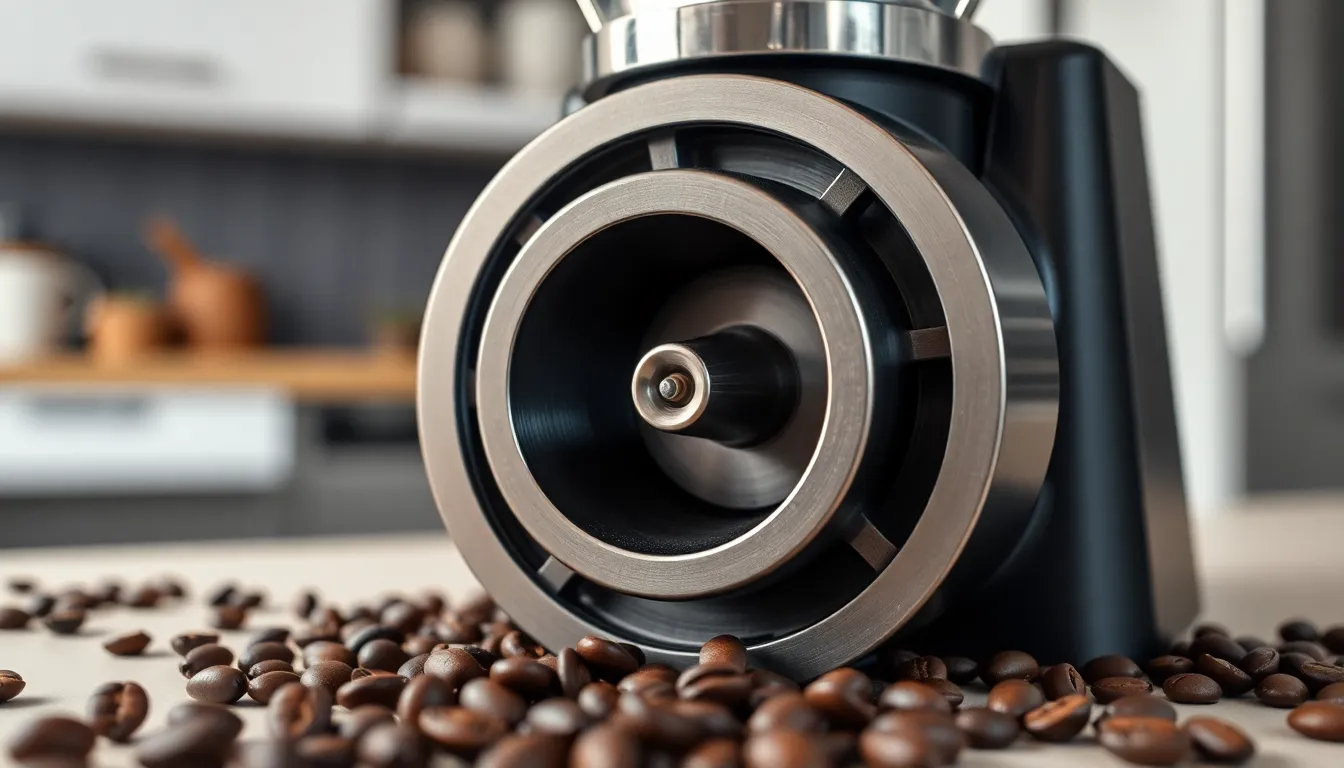
Conical burr grinders represent one of the two main burr grinder designs in the coffee industry, offering distinct characteristics that affect your brewing experience. These grinders have gained popularity among home baristas and professionals alike for their unique construction and grinding properties.
Design and Construction
Conical burr grinders feature a distinctive cone-shaped inner burr that fits inside a ring-shaped outer burr. This design creates a tapered grinding pathway where coffee beans enter through the wider top section and gradually move toward the narrower bottom. One burr remains stationary while the other rotates around it, crushing beans between their serrated surfaces. The conical shape allows these grinders to operate at lower RPMs compared to their flat counterparts, generating less heat during the grinding process. Manufacturers must achieve both parallelism and concentricity when assembling conical burrs, though perfect concentricity can be challenging to attain, occasionally resulting in slight alignment issues.
Grinding Mechanism
Conical burrs crush coffee beans in a unique way that affects the final cup characteristics. As beans travel through the conical pathway, they’re broken down progressively from larger to smaller particles. This grinding action produces a bimodal particle distribution—a mix of both coarse and fine grounds—that contributes to a fuller body and rounder mouthfeel in your coffee. The distance between the conical burrs determines grind size, allowing adjustments from coarse to fine depending on your brewing method. These grinders operate with less noise and heat generation due to their lower operating speeds, preserving more volatile compounds in your coffee beans. The conical design also promotes better bean feeding and reduces retention, meaning fewer grounds get trapped within the grinder, resulting in fresher coffee with each use.
Flat Burr Grinders Explained

Flat burr grinders represent the preferred choice for many specialty coffee professionals due to their exceptional grinding precision and consistency. They feature a distinct design and grinding mechanism that produces a notably different result compared to their conical counterparts.
Design and Construction
Flat burr grinders use two parallel, disc-shaped burrs that sit horizontally across from each other. The burrs are mounted so that one remains stationary while the other rotates, creating a grinding surface between them. This parallel alignment makes it easier to achieve perfect burr parallelism compared to the concentricity challenges faced by conical grinders. The flat design allows for more precise engineering tolerances, resulting in better grinding accuracy and consistency. Most flat burr grinders feature larger motors that power these heavy burrs at higher RPMs, creating a robust grinding system that excels at producing uniform particles.
Grinding Mechanism
Flat burrs crush coffee beans between two parallel grinding surfaces in a highly consistent manner. Coffee enters from above and moves outward between the burrs until it reaches the desired size and exits. This horizontal movement creates a unimodal particle distribution where most grounds end up roughly the same size. The uniform particle size leads to more even extraction during brewing, resulting in greater clarity of flavor and improved balance in the cup. Flat burrs typically require higher RPMs than conical models, which can generate more heat during grinding. But, this drawback is offset by the superior extraction uniformity they provide, particularly for espresso and precision brewing methods where consistency is paramount.
Conical vs Flat Burr: Flavor Profile Differences
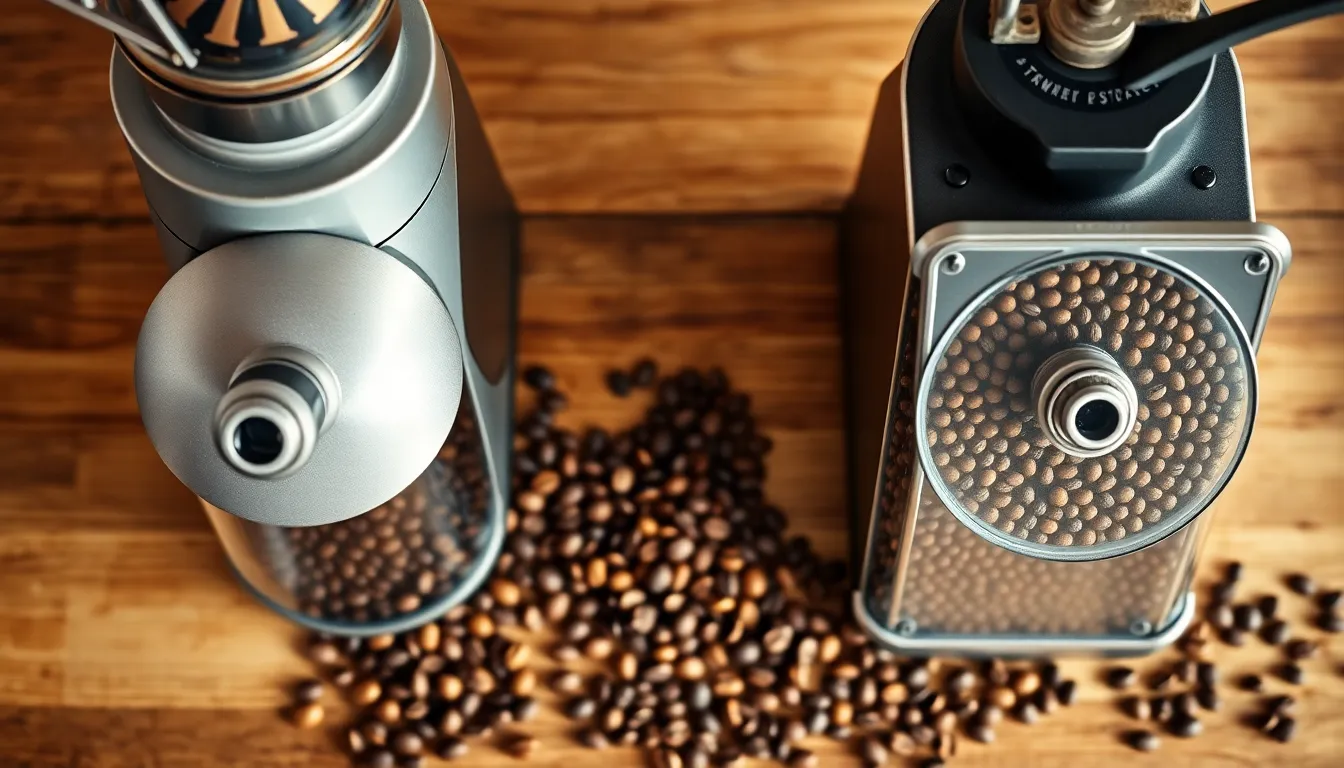
Coffee flavor profiles vary significantly between conical and flat burr grinders due to their distinct grinding mechanisms and resulting particle distributions. These differences directly impact your brewing results and the characteristics you’ll taste in your cup.
Extraction and Taste Notes
Flat burrs create a unimodal grind size distribution with particles that are remarkably uniform in size. This uniformity leads to even extraction throughout your brewing process, capturing bright, sweet notes with exceptional clarity. When brewing with coffee ground by flat burrs, you’ll notice enhanced brightness and sweetness, particularly in pour-over and filter methods where the consistent grind prevents over-extraction and grittiness. The flavor separation allows you to detect the unique characteristics of different coffee beans more distinctly.
Conical burrs produce a bimodal distribution with both fine particles and larger pieces present in your grounds. This mixed particle size creates a more traditional flavor profile with a fuller body and blended tastes that many coffee lovers appreciate. Your espresso shots will typically come out sweeter and fruitier with a richer mouthfeel when using conical burrs. Even though potential uneven extraction (as fines extract faster than larger particles), conical burrs are more forgiving and often easier to dial in for consistent results.
Consistency and Particle Size
Flat burr grinders yield remarkably uniform grounds, contributing to precise extraction control in your brewing process. This consistency makes flat burrs particularly valuable for espresso where clarity and balance are priorities, as well as filter coffee methods where maintaining a consistent flow rate matters. The uniform particle size distribution helps you achieve balanced flavors that highlight the exact characteristics of specialty coffees.
Conical burr grinders create varying particle sizes through their unique grinding action. This variation, while technically less consistent, contributes to traditional coffee textures and complex flavor profiles that many coffee enthusiasts prefer. Your conical grinder will typically have lower retention rates due to its vertical design that utilizes gravity to move coffee through the burrs. This design advantage reduces waste and prevents stale grounds from affecting your next batch, ensuring fresher coffee with each use.
The choice between these two burr types eventually depends on your flavor preferences: flat burrs excel at producing cups with clarity and precision, while conical burrs deliver a traditional, full-bodied experience with more pronounced richness.
Heat Generation and Retention Comparison
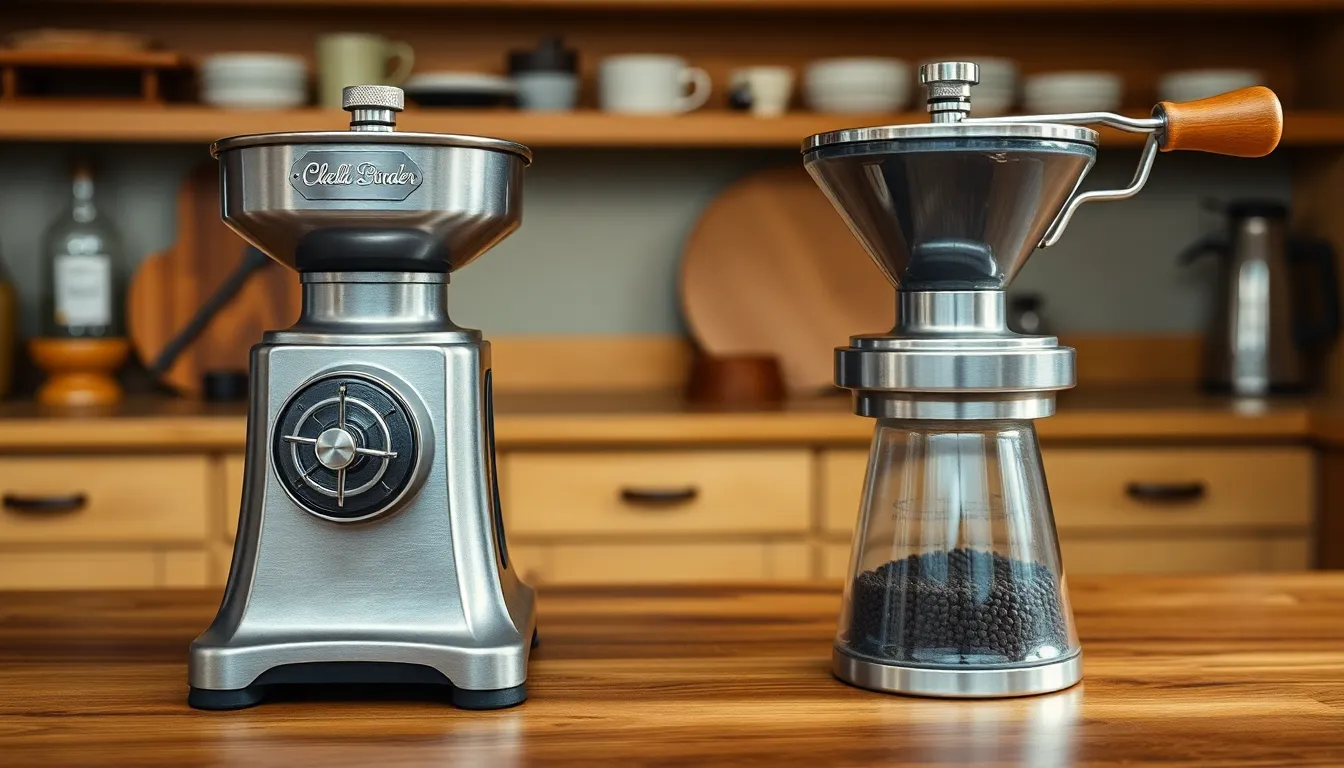
Heat generation varies significantly between flat and conical burr grinders, with important implications for your coffee’s flavor profile. Flat burr grinders typically generate more heat during operation due to their higher rotational speeds (RPMs) and increased mechanical power requirements. This extra friction creates noticeable heat buildup that can potentially alter the aromatic compounds in your coffee beans during grinding.
Conical burrs operate at lower RPMs with a gentler grinding action, producing substantially less heat during the grinding process. Their unique geometry reduces friction between the burrs and coffee beans, resulting in a cooler grinding experience that better preserves delicate flavor compounds.
Heat retention also differs between these grinder types. Flat burr designs tend to retain heat throughout the day, especially in models with limited ventilation. This accumulated heat can affect subsequent grinds and impact flavor consistency across multiple brewing sessions. Conical burrs demonstrate superior heat dissipation properties, maintaining cooler temperatures even during extended use.
The noise level correlates directly with heat production in these grinders. Flat burr models generate more noise alongside their higher heat output, while conical burrs offer a quieter operation thanks to their lower operational speeds and reduced friction.
| Feature | Flat Burrs | Conical Burrs |
|---|---|---|
| Heat Generation | Higher (due to higher RPMs) | Lower (due to lower RPMs) |
| Heat Retention | More heat retained | Less heat retained |
| Impact on Coffee Flavor | Potential degradation of aromatic compounds | Better preservation of flavor notes |
| Noise Level | Noisier operation | Quieter grinding experience |
The temperature factor becomes particularly crucial for espresso enthusiasts and those brewing light-roasted specialty coffees where subtle flavor notes can be easily compromised by excess heat. Your choice between these grinder types should account for how sensitive your preferred coffee beans and brewing method are to temperature fluctuations during the grinding process.
Price and Accessibility Factors
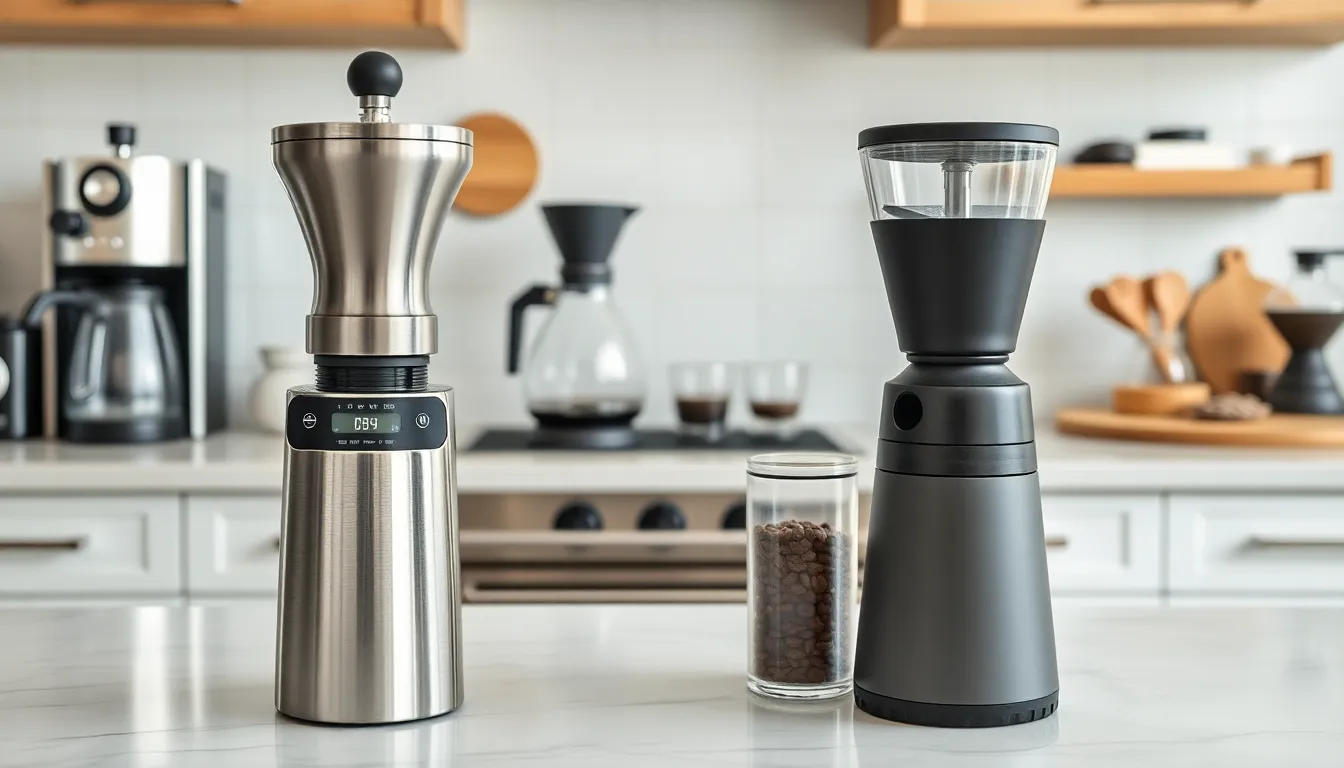
Price
Flat burr grinders typically command a higher price point than their conical counterparts. This price difference stems from their manufacturing requirements—flat burrs need larger, more powerful motors to maintain the high rotational speeds necessary for effective grinding. The precision engineering required to ensure perfect parallelism between the burrs adds further complexity and cost to production.
Conical burr grinders offer a more budget-friendly option for coffee enthusiasts. Their simpler design operates efficiently at lower RPMs, allowing manufacturers to use smaller motors and create more compact units. This streamlined construction translates directly to lower retail prices, making conical burrs the go-to choice for cost-conscious buyers.
Accessibility
Flat burr grinders dominate commercial settings and specialty coffee shops where grind consistency is paramount. Even though their superior precision, several factors limit their home accessibility. The higher price tag puts them out of reach for many casual coffee drinkers. Their louder operation and increased heat generation during grinding can be disadvantageous in residential environments where noise and temperature management matter.
Conical burr grinders excel in home accessibility due to multiple practical advantages. These grinders operate more quietly, generate less heat, and come in both manual and electric formats to suit different preferences. The reduced grind retention in conical models ensures fresher coffee with minimal waste—a important benefit for daily home brewing. Their versatility across brewing methods from espresso to French press makes them adaptable to evolving coffee preferences.
Summary of Key Price & Accessibility Differences
| Feature | Flat Burr Grinders | Conical Burr Grinders |
|---|---|---|
| Price | Higher cost due to motor & design | More affordable, simpler design |
| Motor & Size | Larger motor, bigger grinder | Smaller motor, compact size |
| Noise | Noisier | Quieter |
| Heat Generation | More heat generated | Less heat generated |
| Accessibility | Favored in commercial/specialty use | Widely accessible for home users |
| Grind Consistency | Higher | Slightly less consistent |
The decision between conical and flat burr grinders eventually depends on your priorities and circumstances. Conical burrs provide the best value for home users seeking a balance of performance and affordability. Flat burrs represent an investment for those prioritizing ultimate grind consistency and clarity in flavor, assuming budget constraints aren’t a primary concern.
Maintenance and Longevity
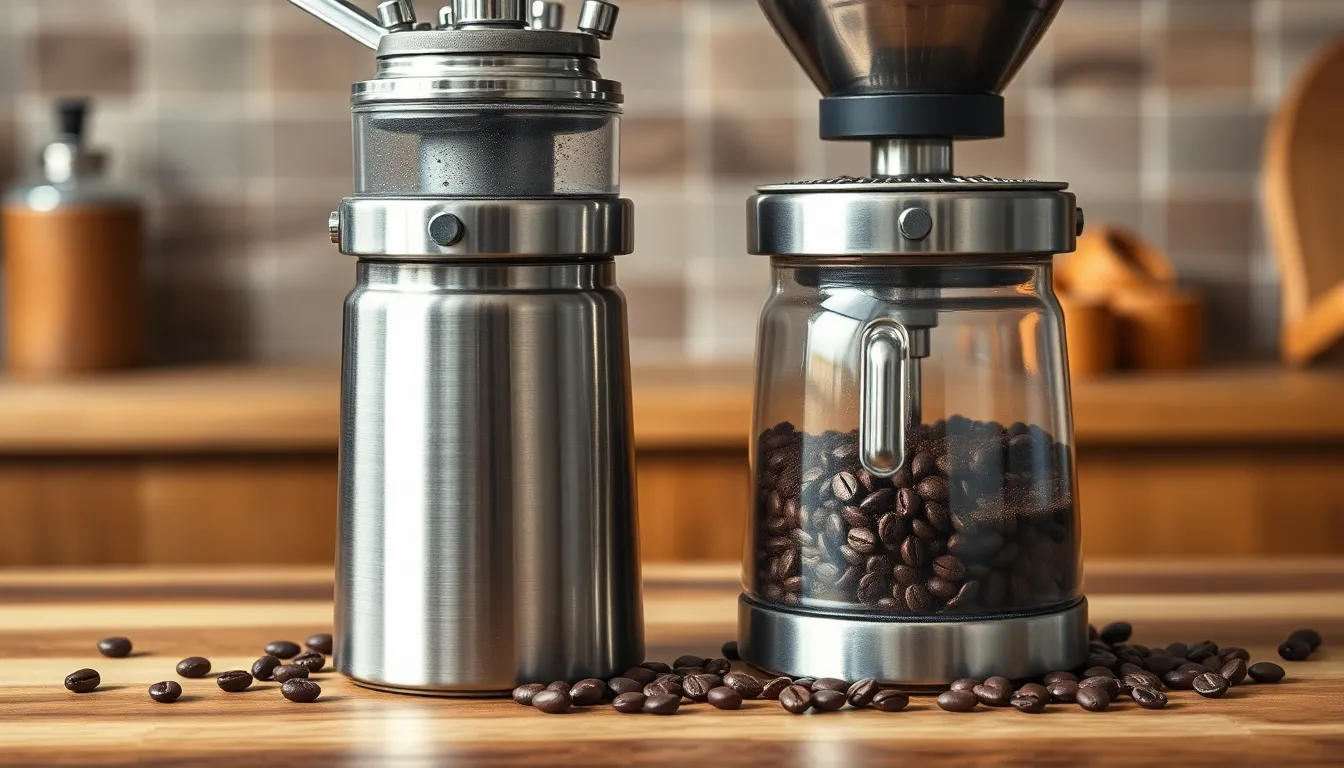
Maintaining your coffee grinder properly extends its lifespan and ensures consistent brewing results. Conical and flat burr grinders differ significantly in their maintenance requirements and overall longevity, affecting both your daily routine and long-term investment.
Conical Burr Grinders
Conical burrs excel in easy maintenance with minimal grind retention. Coffee grounds flow more freely through the conical design, preventing buildup that can compromise performance and flavor integrity. Their lower operating speeds generate less heat during grinding, preserving burr sharpness and extending overall lifespan.
The quieter operation of conical grinders indicates reduced mechanical strain on components, contributing to their durability. Many coffee enthusiasts appreciate this design feature as it translates to less frequent cleaning sessions and simpler maintenance routines.
Flat Burr Grinders
Flat burr grinders typically retain more coffee particles between grinding sessions. Fine grounds often become trapped between the parallel burrs or within the grinding chamber, necessitating more thorough and frequent cleaning to maintain consistency.
The higher RPM operation of flat burrs produces additional heat, potentially accelerating wear on grinding surfaces over time. Even though this challenge, many flat burr grinders feature replaceable burrs, allowing you to upgrade to higher quality components when needed.
Flat burrs demand more attentive maintenance protocols to prevent heat accumulation and preserve grind quality. Their louder operation often signals increased mechanical stress during grinding, which can impact long-term durability without proper care.
| Maintenance Factor | Conical Burrs | Flat Burrs |
|---|---|---|
| Grind Retention | Lower (easier cleaning) | Higher (more frequent cleaning needed) |
| Heat Generation | Minimal (better for flavor preservation) | Substantial (may accelerate burr wear) |
| Noise Level | Quieter (less mechanical strain) | Louder (more mechanical stress) |
| Cleaning Frequency | Less frequent | More frequent |
| Burr Replacement | Less common but possible | Often replaceable with premium options |
The maintenance differences between these grinder types directly affect your daily coffee routine. Conical burrs offer a practical advantage for home users seeking hassle-free upkeep, while flat burrs deliver exceptional precision that justifies their additional maintenance requirements for dedicated coffee enthusiasts.
Which Burr Type Is Right for You?
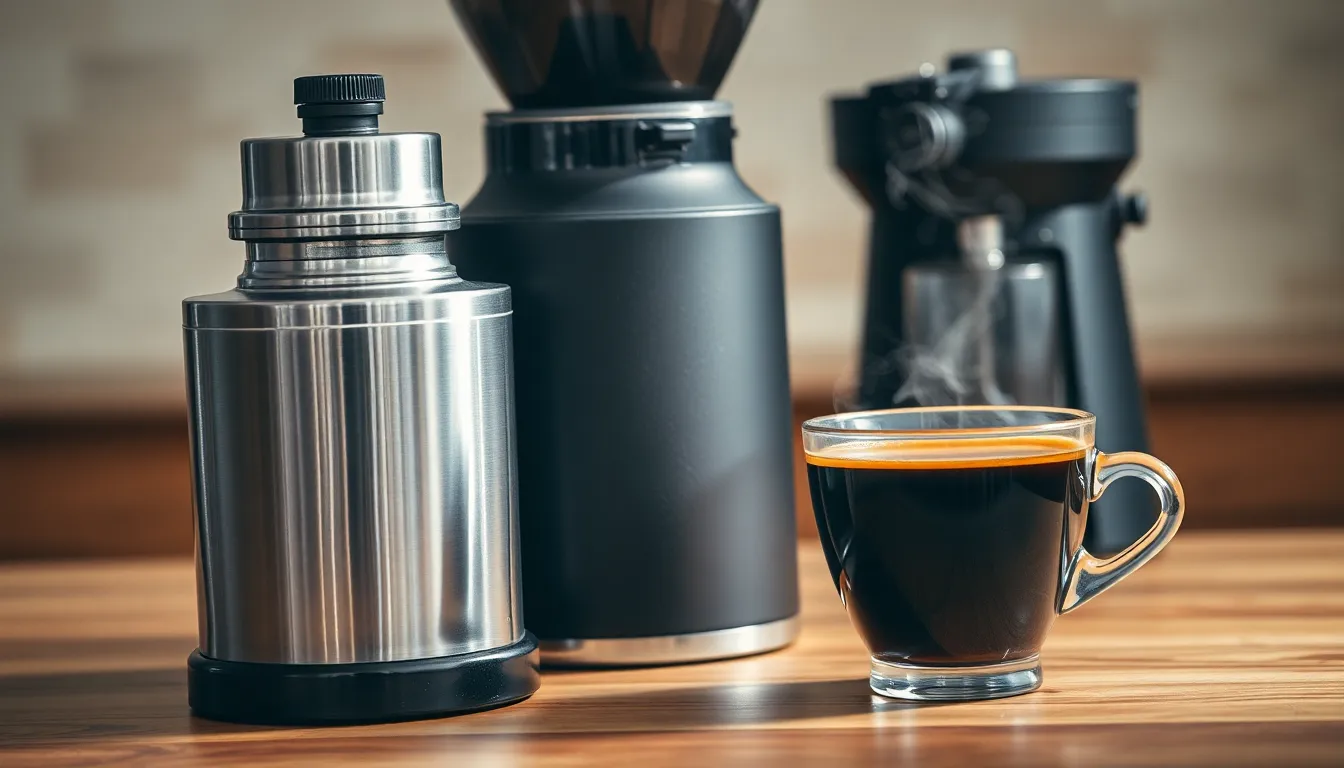
Selecting the ideal burr grinder depends entirely on your brewing preferences, flavor priorities, and practical considerations. Flat burrs excel in producing uniform grinds with exceptional consistency, creating clearer flavor profiles that showcase the unique characteristics of specialty coffees. They’re particularly effective for espresso and pour-over methods where precision extraction matters most.
Conical burrs offer a more traditional coffee experience with a fuller body and rounder mouthfeel that many enthusiasts prefer. Their bimodal particle distribution creates complex flavor profiles with rich, sweet notes that shine in various brewing methods. These grinders operate at lower RPMs, generating less heat and noise while requiring less maintenance.
Consider your budget when making your choice. Flat burr grinders typically cost more due to their precise engineering and manufacturing requirements. Conical models present a more accessible entry point for home brewers without sacrificing quality. The price difference reflects the technical complexity rather than an absolute quality gap.
Your brewing environment matters too. Flat burrs produce more noise during operation, which might be a concern in shared living spaces or early morning brewing sessions. Conical burrs operate more quietly, making them ideal for home use when noise levels are a consideration.
Heat sensitivity of your favorite beans should influence your decision. Light-roasted specialty coffees with delicate flavor compounds benefit from the cooler grinding process of conical burrs. Dark roasts with more robust flavor profiles remain less affected by the additional heat generated by flat burrs.
Maintenance requirements differ significantly between these grinder types. Conical burrs retain less coffee grounds, requiring less frequent cleaning and maintaining flavor integrity across brewing sessions. Flat burrs need more attentive maintenance to prevent buildup that affects performance and flavor quality.
Choose flat burrs if you prioritize maximum consistency, flavor clarity, and precision in your brewing, particularly for espresso or pour-over methods. Select conical burrs if you value a quieter, cooler grinder that’s more affordable, easier to maintain, and produces a richer, fuller coffee body.
Conclusion
Choosing between conical and flat burr grinders eventually comes down to your personal brewing style and flavor preferences. Flat burrs deliver precision consistency and clarity that highlights bright notes in your coffee with uniform particle distribution. They’re ideal for espresso enthusiasts willing to invest in premium equipment and manage additional maintenance.
Conical burrs offer a more accessible entry point with their fuller-bodied flavor profiles richer mouthfeel and bimodal grind distribution. They run cooler quieter and require less maintenance making them perfect for home brewing environments.
Your decision should align with your coffee journey priorities. Whether you value the technical precision of flat burrs or the practical versatility of conical burrs both will elevate your brewing experience far beyond blade grinders and pre-ground coffee.
Frequently Asked Questions
What’s the main difference between conical and flat burr grinders?
Conical burrs have a cone-shaped design with one burr fitting inside another, while flat burrs feature two parallel disc-shaped surfaces. Conical burrs operate at lower RPMs generating less heat and noise, producing a bimodal particle distribution for fuller-bodied coffee. Flat burrs create more uniform particles (unimodal distribution) for clearer flavor profiles but run hotter and louder.
Which type of burr grinder is better for espresso?
Both can excel for espresso, but they produce different results. Flat burrs create uniform particle sizes that lead to balanced, clear flavor notes with bright acidity. Conical burrs produce a bimodal distribution resulting in richer, sweeter espresso shots with fuller body. Professional baristas often prefer flat burrs for precision, while many home enthusiasts enjoy conical burrs.
Do flat burr grinders really produce more heat?
Yes. Flat burr grinders typically operate at higher RPMs than conical grinders, generating more heat during the grinding process. This increased heat production can potentially affect delicate aromatic compounds in coffee beans. Additionally, flat burrs tend to retain heat longer, which may impact flavor consistency when grinding multiple batches consecutively.
Are conical burr grinders easier to maintain?
Absolutely. Conical burr grinders typically retain less coffee grounds between uses, requiring less frequent cleaning. Their lower operating speeds generate less heat and friction, which extends burr longevity. The design also makes them easier to access for routine cleaning. Flat burrs generally require more attentive maintenance to prevent buildup and manage heat accumulation.
Which burr grinder is more affordable?
Conical burr grinders are generally more affordable than flat burr alternatives. Their simpler design and manufacturing process translates to lower retail prices, making them more accessible for home users. Quality flat burr grinders typically command higher prices due to their precision engineering and tighter manufacturing tolerances. For budget-conscious buyers, conical burrs offer better value.
How do burr grinders affect coffee flavor?
Burr grinders affect flavor through particle size distribution. Flat burrs produce uniform particles that extract evenly, highlighting bright, sweet notes with clarity—ideal for light roasts and pour-overs. Conical burrs create a mix of particle sizes that results in fuller body, complex sweetness, and a traditional coffee experience. The choice significantly impacts your cup’s flavor profile.
Are flat burr grinders noisier than conical ones?
Yes, flat burr grinders typically produce more noise than conical models. This is primarily due to their higher operational speeds (RPMs) required to achieve the same grinding result. The noise difference can be significant in home environments, particularly in shared living spaces or when brewing early in the morning. Conical burrs offer a quieter grinding experience.
Which type of grinder is better for pour-over coffee?
For pour-over methods, flat burr grinders often have an edge due to their uniform particle size distribution, which promotes even extraction and clarity in the cup. This consistency highlights the bright, nuanced flavors prized in pour-over brewing. However, conical burrs can still produce excellent pour-over results with a slightly fuller body that some brewers prefer.




















